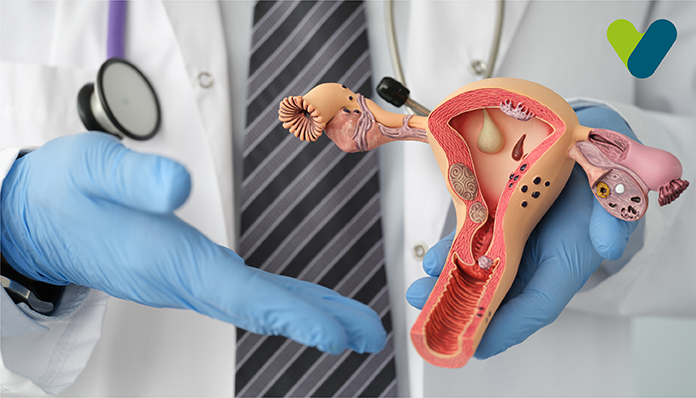Karabi (40-years-old) is a working woman who is staying with her husband and a son in Hyderabad. Over the past few months, Karabi was experiencing a heavy and painful menstruation cycle along with lower back pain. She took some painkillers to subside the pain, but the symptoms didn’t go away. She discussed her problems with her husband and they both went to a gynecologist. After performing some tests, it has been found that Karabi has endometriosis. The doctor prescribed some medications and also recommended changing her lifestyle a little bit. Now, Karabi has started feeling better and her symptoms are also improving gradually.
Here, we are going to mention what endometriosis is and will also discuss more about some endometriosis treatment methods.
What is Endometriosis?
Endometriosis is a disease where a similar kind of uterus lining tissue grows in other parts of your body. These patches of tissue are called "implants," "nodules," or "lesions." These tissues are commonly found under the ovaries or uterus, on the fallopian tubes, or the bladder.Symptoms of Endometriosis
Some common symptoms of endometriosis are,- Pelvic pain that occurs mainly during your menstruation cycle
- Infertility
Other Possible Symptoms
- Extremely painful menstrual cramps
- Pain after intercourse
- Pain in lower abdomen and intestine
- Pain during urination or bowel movements
- Heavy menstrual bleeding
- Spotting or bleeding between periods
- Digestive or gastrointestinal problems
- Fatigue or lethargy
Causes of Endometriosis
The exact causes of endometriosis are not known.- The prime cause of endometriosis is retrograde menstruation which is common among most women (90% of women). This occurs when menstrual blood flows back from your fallopian tubes into your pelvic cavity instead of removing through the vagina.
- Sometimes, hormonal changes convert the outside cells of the uterus into cells like those lining that are found inside of the uterus (called endometrial cells).
- Some experts also believe that you may experience this condition when small parts of your abdomen convert into endometrial tissue. This occurs because some cells in your abdomen grow from embryonic cells, which can change shape and behave like endometrial cells. These displaced endometrial cells are commonly found on your pelvic walls and other organs like the bladder, ovaries, and rectum. They grow gradually and cause pseudo bleeding like your menstrual cycle in response to your hormones.
- Some other theories purport that endometriosis occurs due to the improper function of the immune system. In such a scenario, your immune system can’t destroy sinful endometrial cells.
- Some experts also believe that endometriosis starts in the fetal period with misplaced cell tissue as a response to the hormones of puberty. This theory is called Mullerian theory.
- Endometriosis development is also linked to genetics
Endometriosis Stages
Stage 1: MinimalIn minimal endometriosis, only small lesions or wounds are found. Endometrial implants are thin and narrow on your ovaries. Inflammation could be present in or around your pelvic cavity.
Stage 2: Mild
In this type of endometriosis, you may experience mild lesions and shallow implants on the ovaries and the pelvic region.
Stage 3: Moderate
Here, you may notice many deep implants on your ovaries and pelvic lining. Lesions are also more as compared to mild and moderate.
Stage 4: Severe
This is the most critical phase of endometriosis where you can observe many deep implants on your pelvic lining and ovaries. There could also be some abrasions on your fallopian tubes and bowels. These can be found in one or both of your ovaries.
Diagnosis
Endometriosis symptoms have many resemblances to the symptoms of ovarian cysts, pelvic inflammatory disease, and irritable bowel disease (IBS)To diagnose your condition, your doctor may perform one or more of the following tests.
Detailed History
By examining physically, your doctor will check your symptoms and family history of endometriosis. A general health assessment will help your doctor to determine whether there is any more underlying disorder or not.Physical Exam
Your doctor will perform a pelvic exam by using a speculum and light to see inside of the vagina and cervix. They will physically check your abdomen for cysts or scars behind the uterus.Ultrasound
Your doctor will recommend either a transvaginal ultrasound or an abdominal ultrasound. In a transvaginal ultrasound, a probe is inserted into your vagina. Both ultrasounds will give images of reproductive organs. Thus, your doctor will identify cysts associated with endometriosis.Laparoscopy
This is the only method that identifies endometriosis by viewing it directly. This process is done by a minor surgical procedure called laparoscopy. After diagnosis, the tissue is removed in the same way.What are the Treatments for Endometriosis?
At present, there is no endometriosis cure treatment. Treatments can only control the symptoms of the condition. Based on your condition and reports, your doctor will decide the best line of treatments for you.Treatments for Endometriosis Pain
1. Pain Relievers
You can purchase some over-the-counter anti-inflammatory drugs (NSAIDs) such as ibuprofen to control the pain. Healthcare providers may sometimes prescribe opioids for severe pain.2. Hormone Therapy
hormone therapies including progestin therapy and gonadotropin-releasing hormone (GnRH) agonists are effective in treating endometriosis. GnRH agonists may cause temporary menopause but is also beneficial in controlling the growth of endometriosis.3. Surgical Treatments
These treatments are recommended for severe pain. Endometriosis ablation is a surgical procedure that kills (ablates) the lining of your uterus (endometrium). Sometimes major surgeries are needed if there are cancerous tissues or cells.These are some endometrioma treatment methods that are useful in managing your symptoms.

